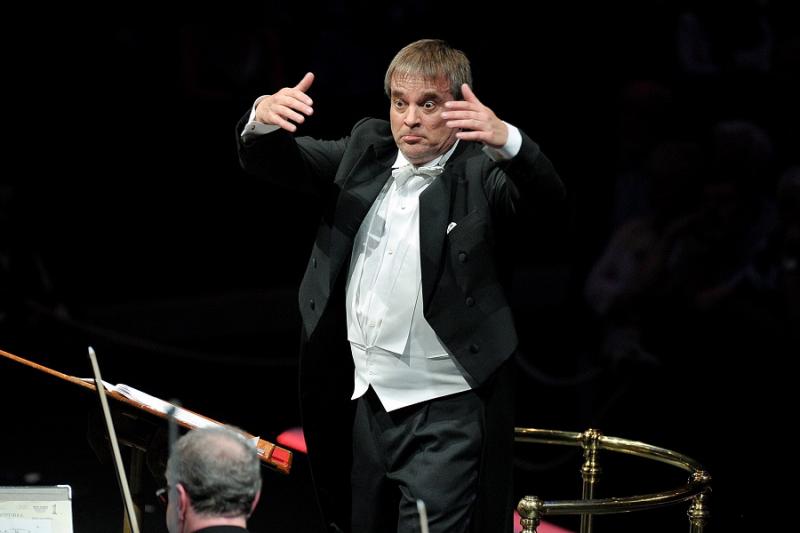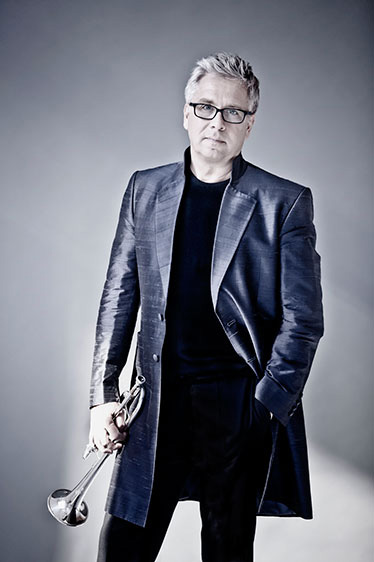BBCSO, Storgårds, Barbican review – Jolas intrigues, Mahler 4 disappoints | reviews, news & interviews
BBCSO, Storgårds, Barbican review – Jolas intrigues, Mahler 4 disappoints
BBCSO, Storgårds, Barbican review – Jolas intrigues, Mahler 4 disappoints
The French composer, working with Roger Muraro and Håkan Hardenberger, is still radical at 91

Betsy Jolas is a pioneer, the programme for this BBC Symphony Orchestra concert told us, and she’s certainly unique. Now 91, she has been following her own course for many decades, an associate of the 1960s French avant-garde, but never a subscriber to its doctrines. Her concerto for piano and trumpet, Histoires vraies (2015), here received its UK premiere.
The title means "True stories", and Jolas links this idea with the expression of "sounds we try not to hear". It also vaguely biographical, conveying "a strong wish to play together" on the part of the two soloists, pianist Roger Muraro and trumpeter Håken Hardenberger (pictured below). The trumpeter was presumably the motivating force behind this project, given his taste for Dadaesque projects (particularly with H. K. Gruber), but Jolas takes that dark, surreal humour to another level, with counterintuitive progressions and disorientating juxtapositions at every turn.
The idea of "sounds we try not to hear" suggests an objet trouvé approach, and the large percussion section begins the work by assembling a range of unpitched and disorganised noises, already playing before the conductor and soloists take the stage. When the music proper begins, the piano part fleshes these out, while the strings play short melodic motifs, accompaniment perhaps, but seemingly unrelated. The piano and trumpet have a more cordial relationship, neither performing overtly virtuosic music (until the stratospheric coda for the trumpet) and instead relaxing into laid-back bluesy textures.
 Both soloists have shadows in the ensemble, the trumpeter often echoed by the orchestral first trumpet, the piano by another pianist and by the harp. But everything remains provisional and ungrounded, and rather than cohere, the separate ideas simply play out in parallel. There is an incisive aspect to Jolas’s music too, with slaps and bangs from the percussion often cutting through the more nebulous textures. This comes to a head at the end, where the pianist repeatedly hits the lid of the piano against the front of the case, and clapping from the orchestra ends the piece, a decisive conclusion but as surreal as everything it follows.
Both soloists have shadows in the ensemble, the trumpeter often echoed by the orchestral first trumpet, the piano by another pianist and by the harp. But everything remains provisional and ungrounded, and rather than cohere, the separate ideas simply play out in parallel. There is an incisive aspect to Jolas’s music too, with slaps and bangs from the percussion often cutting through the more nebulous textures. This comes to a head at the end, where the pianist repeatedly hits the lid of the piano against the front of the case, and clapping from the orchestra ends the piece, a decisive conclusion but as surreal as everything it follows.
The concert opened with two short works from Lili Boulanger, the short-lived French composer known today largely through the championship of her sister Nadia. The two works, D’un matin de printemps and D’un soir triste, are expansions of chamber pieces, as is clear from their unsophisticated orchestration. Like the Jolas, this music is difficult to pin down. The style is romantic and melodic, but not overtly expressive, and a sense of neoclassical reserve pervades both pieces. The second piece has a surprisingly dissonant climax, but it is prepared and resolved with typical Boulanger sophistication.
Mahler’s Fourth Symphony made up the second half of the programme, a curious coupling, perhaps inspired by the similarities between the sleigh bell openings of the Mahler and the Boulanger. John Storgårds led a propulsive, dynamic and often brash account. The difficult transitions in the first movement often caused ensemble problems, but the climaxes were impressive, with the woodwinds mostly maintaining their tone and ensemble at the loud dynamics. Storgårds took a liberty with the coda, bringing the music down to the quietest imaginable dynamics and an unfeasibly slow tempo and then building up to a huge climax – thrilling but disproportionate.
Some sprightly solo violin turns from guest leader Florian Donderer brought vitality and life to the second movement, although again, Storgårds' excesses with the Ländler rhythms, lingering on every downbeat, disrupted the flow. Tempos in the Ruhevoll (restful) third movement were again on the fast side, but fluid and varied, bringing a valuable sense of structure to music that too often sags. Soprano Susanna Hurrell was unsteady at her first entrance in the finale, but soon found her form, although with her wide, operatic vibrato, she gave little sense of the “childlike manner” specified in the score. Storgårds continued to draw strident textures from the orchestra, and Hurrell often struggled to be heard. And even at the very end, the solo harp that should fade to silence plucked away emphatically until the very last bar. As in the Jolas, the performance style here seemed deliberately brash and unaffected, but it didn’t suit Mahler at all.
The future of Arts Journalism
You can stop theartsdesk.com closing!
We urgently need financing to survive. Our fundraising drive has thus far raised £49,000 but we need to reach £100,000 or we will be forced to close. Please contribute here: https://gofund.me/c3f6033d
And if you can forward this information to anyone who might assist, we’d be grateful.

Subscribe to theartsdesk.com
Thank you for continuing to read our work on theartsdesk.com. For unlimited access to every article in its entirety, including our archive of more than 15,000 pieces, we're asking for £5 per month or £40 per year. We feel it's a very good deal, and hope you do too.
To take a subscription now simply click here.
And if you're looking for that extra gift for a friend or family member, why not treat them to a theartsdesk.com gift subscription?
more Classical music
 Solomon, OAE, Butt, QEH review - daft Biblical whitewashing with great choruses
Even a top soprano and mezzo can’t make this Handel paean wholly convincing
Solomon, OAE, Butt, QEH review - daft Biblical whitewashing with great choruses
Even a top soprano and mezzo can’t make this Handel paean wholly convincing
 Two-Piano Gala, Kings Place review - shining constellations
London Piano Festival curators and illustrious friends entertain and enlighten
Two-Piano Gala, Kings Place review - shining constellations
London Piano Festival curators and illustrious friends entertain and enlighten
 Echo Vocal Ensemble, Latto, Union Chapel review - eclectic choral programme garlanded with dance
Beautiful singing at the heart of an imaginative and stylistically varied concert
Echo Vocal Ensemble, Latto, Union Chapel review - eclectic choral programme garlanded with dance
Beautiful singing at the heart of an imaginative and stylistically varied concert
 Scott, Irish Baroque Orchestra, Whelan, RIAM, Dublin review - towards a Mozart masterpiece
Characteristic joy and enlightenment from this team, but a valveless horn brings problems
Scott, Irish Baroque Orchestra, Whelan, RIAM, Dublin review - towards a Mozart masterpiece
Characteristic joy and enlightenment from this team, but a valveless horn brings problems
 Classical CDs: Voice flutes, flugelhorns and froth
Baroque sonatas, English orchestral music and an emotionally-charged vocal recital
Classical CDs: Voice flutes, flugelhorns and froth
Baroque sonatas, English orchestral music and an emotionally-charged vocal recital
 Kanneh-Mason, Britten Sinfonia, Shave, Milton Court - a grin and a big beaming smile
A pair of striking contemporary pieces alongside two old favourites
Kanneh-Mason, Britten Sinfonia, Shave, Milton Court - a grin and a big beaming smile
A pair of striking contemporary pieces alongside two old favourites
 theartsdesk at the New Ross Piano Festival - Finghin Collins’ musical rainbow
From revelatory Bach played with astounding maturity by a 22 year old to four-hand jazz
theartsdesk at the New Ross Piano Festival - Finghin Collins’ musical rainbow
From revelatory Bach played with astounding maturity by a 22 year old to four-hand jazz
 First Person: Manchester Camerata's Head of Artistic Planning Clara Marshall Cawley on questioning the status quo
Five days of free events with all sorts of audiences around Manchester starts tomorrow
First Person: Manchester Camerata's Head of Artistic Planning Clara Marshall Cawley on questioning the status quo
Five days of free events with all sorts of audiences around Manchester starts tomorrow
 Goldscheider, Brother Tree Sound, Kings Place review - music of hope from a young composer
Unusual combination of horn, strings and electronics makes for some intriguing listening
Goldscheider, Brother Tree Sound, Kings Place review - music of hope from a young composer
Unusual combination of horn, strings and electronics makes for some intriguing listening
 theartsdesk Q&A: composer Donghoon Shin on his new concerto for pianist Seong-Jin Cho
Classical music makes its debut at London's K-Music Festival
theartsdesk Q&A: composer Donghoon Shin on his new concerto for pianist Seong-Jin Cho
Classical music makes its debut at London's K-Music Festival

Add comment